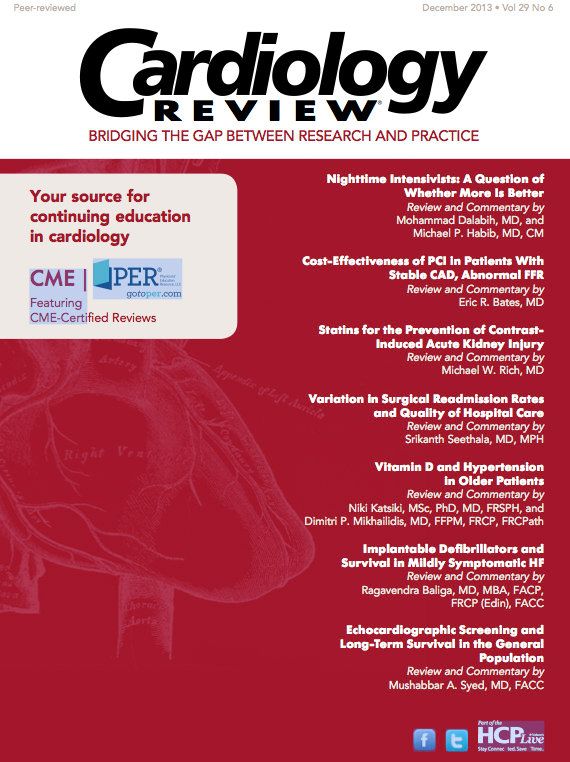Publication
Article
Cardiology Review® Online
Statins for the Prevention of Contrast-Induced Acute Kidney Injury
Author(s):
Two new studies provide much food for thought concerning the use of statins for the prevention of contrast-induced acute kidney injury (CI-AKI).

Michael W. Rich, MD
Review
Leoncini M, Toso A, Maioli M, Tropeano F, Villani S, Bellandi F. Early high-dose rosuvastatin for contrast-induced nephropathy prevention in acute coronary syndrome. Results from Protective effect of Rosuvastatin and Antiplatelet Therapy On contrast-induced acute kidney injury and myocardial damage in patients with Acute Coronary Syndrome (PRATO-ACS Study). J Am Coll Cardiol. 2013;doi:10.1016/j.jacc.2013.04.105.
Han Y, Zhu G, Han L, et al. Short-term rosuvastatin therapy for prevention of contrast-induced acute kidney injury in patients with diabetes and chronic kidney disease. J Am Coll Cardiol. 2013; doi:10.1016/j.jacc.2013.09.017.

The incidence of contrast-induced acute kidney injury (CI-AKI) following coronary angiography ranges from 5% to 15% depending on the population studied. Statins, through their pleiotropic effects, may reduce the incidence of CI-AKI, but prior investigations have been inconclusive. Two recent reports published in the Journal of the American College of Cardiology have generated renewed interest in the potential role of statins for prevention of CI-AKI.1,2
Study Details
In the first study, Leoncini et al randomized 504 statin-naïve patients undergoing coronary angiography with possible percutaneous coronary intervention (PCI) to receive either rosuvastatin 40 mg on admission, followed by 20 mg daily (N = 252), or no statin therapy (N = 252).1 The mean age was 66 years, 66% were men, and the 2 groups were well balanced with respect to all clinical, angiographic, and therapeutic characteristics, including baseline renal function, diabetes, time to angiography, severity of coronary artery disease, left ventricular ejection fraction, contrast volume, and use of pharmacologic agents. CI-AKI was defined as an increase in creatinine ≥0.5 mg/ dL or ≥25% of baseline within 72 hours after contrast administration.
The incidence of CI-AKI was 6.7% in the rosuvastatin group compared with 15.1% in the control group (adjusted odds ratio [OR], 0.38; 95% confidence interval [CI], 0.20-0.71; P = .003), yielding a number-needed-to-treat (NNT) of 12 patients to prevent 1 CI-AKI event. The 30-day incidence of the composite outcome of death, persistent renal damage, dialysis, myocardial infarction (MI), or stroke was lower in the statin group (3.6% vs 7.9%; P = 0.036), being driven primarily by persistent renal damage in the control group. There was a trend for patients <70 years of age to derive greater benefit from rosuvastatin than patients ≥70 years (P = .06 for interaction), but benefits were similar in all other prespecified subgroups. At 6-month followup, the rate of death or non-fatal MI was nonsignificantly lower in the rosuvastatin group (3.6% vs 7.2%; P = .07).
In the second study, Han et al randomized 2998 patients with type 2 diabetes and stage II or III chronic kidney disease (CKD) undergoing coronary or peripheral arterial angiography with or without intervention to rosuvastatin 10 mg for 5 days (2 days before and 3 days after the procedure; N = 1498), or to usual care (N = 1500).2 The mean age of the patients was 61 years, 65% were men, and the groups were well balanced with respect to baseline characteristics. CI-AKI was defined using the same criteria as Leoncini et al.1 The incidence of CI-AKI 72 hours after contrast exposure was 2.3% in the rosuvastatin group compared with 3.9% in the control group (OR, 0.58; 95% CI, 0.38-0.89; P = .01); the NNT to prevent 1 CI-AKI event was 62.5 patients. The authors reported no significant differences across various subgroups. At 30-day follow-up, mortality and need for hemodialysis were low in both groups (<0.5%), but worsening heart failure, defined as a change in New York Heart Association class, was more common in the control group than in the rosuvastatin group (4.3% vs 2.6%; P = .02).
CommentaryNew Evidence Supporting Statin Use to Prevent CI-AKI
Contrast-induced acute kidney injury (CI-AKI) is defined as a 0.5 mg/dL or ≥25% increase in serum creatinine from baseline within 72 hours of administration of contrast medium.3 The overall incidence of CI-AKI ranges from 5% to 15%, but varies widely from <3% in low-risk patients to more than 50% in very high risk patients.4 The most important risk factors for CI-AKI include preexisting renal dysfunction, diabetes mellitus, intravascular volume contraction, and hemodynamic instability, especially decompensated heart failure, hypotension, or shock.4,5 Patients undergoing percutaneous coronary intervention (PCI) in the context of acute coronary syndrome (ACS) are also at increased risk. Additional risk factors include age ≥75 years, high contrast volume (≥200 mL), and anemia.
In the United States approximately 1 million cardiac catheterizations and 600,000 PCIs are performed each year.6 Assuming a 10% incidence of CI-AKI, an estimated 100,000 to 150,000 new cases occur annually. While CI-AKI is usually transient, with recovery within 7 to 14 days, it is nonetheless associated with increased hospital mortality and length of stay, as well as increased costs. In addition, although <0.5% of patients require dialysis following contrast administration, CI-AKI is a marker for worsening renal function during follow-up.
For these reasons, there has been considerable interest in developing strategies aimed at prevention of CI-AKI. To date, the only measure consistently shown to be beneficial is adequate hydration before and after the procedure.7 A recent meta-analysis concluded that the addition of sodium bicarbonate to standard hydration is superior to normal saline alone for reducing the incidence of CI-AKI.8 Data on N-acetylcysteine have been mixed, and a recent large randomized trial failed to demonstrate benefit from this agent.9 Other interventions, including furosemide, mannitol, adenosine antagonists, natriuretic peptides, and low-dose dopamine, have been ineffective.
Although the precise mechanisms responsible for CI-AKI have not been fully elucidated, statins have several properties that make them attractive candidates for prophylaxis, including favorable effects on inflammation, oxidative stress, endothelial function, and atherosclerosis. Indeed, multiple prior studies have evaluated the use of statins for prevention of CI-AKI, and a meta-analysis of 7 randomized trials published in 2012 reported a significant reduction in CI-AKI with statin therapy (relative risk, 0.51; 95% CI, 0.34-0.76; P = .001). However, due to the heterogeneity of the trials, the authors concluded that only a “limited recommendation” could be made in support of statins for prevention of CI-AKI.10
The reports by Leoncini and Han provide important new evidence in support of a role for statins prior to angiography. Both studies were prospective randomized trials targeting high-risk populations (ACS or type 2 diabetes mellitus with CKD), and the combined sample size of 3502 subjects was 2.5-fold higher than the 2012 meta-analysis. Both studies used currently accepted criteria for CI-AKI, and both trials compared rosuvastatin with a nonstatin control group (although rosuvastatin dosages differed). In both studies, rosuvastatin therapy was associated with significant reductions in CI-AKI, as well as favorable effects on clinical outcomes during follow-up. In conjunction with prior studies, these trials appear to provide strong support for routine statin administration to high-risk patients undergoing coronary angiography and possible PCI.
Despite the strengths and consistency of findings in these 2 trials, there are some important limitations. Treatment assignment was open-label in both studies, which may introduce bias if post procedure management was not identical in the 2 groups. Both studies enrolled carefully defined high-risk populations, so that the generalizability of the findings to other populations, especially lower-risk patients, is uncertain. Clinical events were relatively infrequent, so that the cost-effectiveness of statin therapy is unknown. The study by Leoncini et al was of modest size and was conducted at a single center in Italy. Moreover, despite the fact that all patients received intravenous hydration with normal saline and N-acetylcysteine 1200 mg BID prior to the procedure, the incidence of CI-AKI in the control group was remarkably high at 15.1%. By comparison, the incidence of CI-AKI in the control group in the much larger study reported by Han et al was only 3.9%. An important limitation of the latter study, however, was that peri-procedural hydration was not standardized and was left to the discretion of the physician. Moreover, less than 50% of patients in both groups were reported as having received hydration, and there was no apparent benefit from rosuvastatin among hydrated patients, a finding that requires further clarification, and which may undermine the conclusions of the trial.
As with all studies, the results of these trials raise questions that should prompt additional investigation. Are the findings a class effect of statins, or are they specific to rosuvastatin? What is the effect of statin prophylaxis on clinical outcomes following coronary angiography or PCI (an important question given that CI-AKI is reversible in a high proportion of cases)? Are statins beneficial in other populations, including those at lower risk for CI-AKI? What is the cost-effectiveness of statin therapy in this context? What is the optimal statin dose, and is there benefit of increasing the dose in patients already receiving statins prior to a procedure?
In summary, the studies by Leoncini and Han add to a growing body of literature that supports the use of statins for prevention of CI-AKI, at least in selected high-risk populations. Although the findings are not definitive and additional studies are needed, given the excellent safety profile of statins and the established benefits of these drugs in patients with known vascular disease or diabetes, it seems very reasonable to prescribe statin therapy prior to coronary angiography or PCI in patients at moderate to high risk for CIAKI.
References
1. Leoncini M, Toso A, Maioli M, Tropeano F, Villani S, Bellandi F. Early high-dose rosuvastatin for contrast-induced nephropathy prevention in acute coronary syndrome: results from Protective effect of Rosuvastatin and Antiplatelet Therapy On contrast-induced acute kidney injury and myocardial damage in patients with Acute Coronary Syndrome (PRATOACS Study). J Am Coll Cardiol. doi:10.1016/j.jacc.2013.04.105.
2. Han Y, Zhu G, Han L, et al. Short-term rosuvastatin therapy for prevention of contrast-induced acute kidney injury in patients with diabetes and chronic kidney disease. J Am Coll Cardiol. doi:10.1016/j.jacc.2013.09.017.
3. Barrett BJ, Parfrey PS. Preventing nephropathy induced by contrast medium. N Engl J Med. 2006;354:379-386.
4. Mehran R, Aymong ED, Nikolsky E, et al. A simple risk score for prediction of contrast-induced nephropathy after percutaneous coronary intervention: development and initial validation. J Am Coll Cardiol. 2004;44: 1393-1399.
5. Solomon R, Dauerman HL. Contrast-induced acute kidney injury. Circulation. 2010;122:2451-2455.
6. Go AS, Mozaffarian D, Roger VL, et al. Heart disease and stroke statistics-- 2013 update: a report from the American Heart Association. Circulation. 2013;127:e6-e245.
7. Weisbord SD, Palevsky PM. Prevention of contrast-induced nephropathy with volume expansion. Clin J Am Soc Nephrol. 2008;3:273-280.
8. Jang JS, Jin HY, Seo JS, et al. Sodium bicarbonate therapy for the prevention of contrast-induced acute kidney injury - a systematic review and meta-analysis. Circ J. 2012;76:2255-2265.
9. ACT Investigators. Acetylcysteine for prevention of renal outcomes in patients undergoing coronary and peripheral vascular angiography: main results from the randomized Acetylcysteine for Contrast-induced nephropathy Trial (ACT). Circulation. 2011;124:1250-1259.
10. Li Y, Liu Y, Fu L, Mei C, Dai B. Efficacy of short-term high-dose statin in preventing contrast-induced nephropathy: a meta-analysis of seven randomized controlled trials. PLoS ONE. 2012;7:e34450.
About the Author
Michael W. Rich, MD, is Professor of Medicine and Cardiology at the Washington University School of Medicine, and Director of the Cardiac Rapid Evaluation Unit at Barnes-Jewish Hospital in St. Louis, MO. Dr. Rich’s primary research focus has been the prevention and treatment of cardiovascular disease in the aging population. He has participated in numerous investigator-initiated and multicenter clinical trials involving elderly cardiac patients, and he has published extensively on heart failure disease management, coronary heart disease, atrial fibrillation, and cardiovascular risk reduction in the elderly. Dr. Rich is an internationally recognized expert in geriatric cardiovascular disease, and he is past president of the Society of Geriatric Cardiology. He is an Associate Editor for the Journal of the American Geriatrics Society and the American Journal of Medicine.






